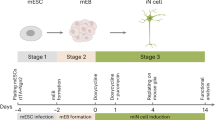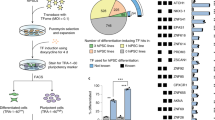Abstract
Somatic cell nuclear transfer, cell fusion, or expression of lineage-specific factors have been shown to induce cell-fate changes in diverse somatic cell types1,2,3,4,5,6,7,8,9,10,11,12. We recently observed that forced expression of a combination of three transcription factors, Brn2 (also known as Pou3f2), Ascl1 and Myt1l, can efficiently convert mouse fibroblasts into functional induced neuronal (iN) cells13. Here we show that the same three factors can generate functional neurons from human pluripotent stem cells as early as 6 days after transgene activation. When combined with the basic helix–loop–helix transcription factor NeuroD1, these factors could also convert fetal and postnatal human fibroblasts into iN cells showing typical neuronal morphologies and expressing multiple neuronal markers, even after downregulation of the exogenous transcription factors. Importantly, the vast majority of human iN cells were able to generate action potentials and many matured to receive synaptic contacts when co-cultured with primary mouse cortical neurons. Our data demonstrate that non-neural human somatic cells, as well as pluripotent stem cells, can be converted directly into neurons by lineage-determining transcription factors. These methods may facilitate robust generation of patient-specific human neurons for in vitro disease modelling or future applications in regenerative medicine.
This is a preview of subscription content, access via your institution
Access options
Subscribe to this journal
Receive 51 print issues and online access
$199.00 per year
only $3.90 per issue
Buy this article
- Purchase on Springer Link
- Instant access to full article PDF
Prices may be subject to local taxes which are calculated during checkout




Similar content being viewed by others
References
Blau, H. M. et al. Plasticity of the differentiated state. Science 230, 758–766 (1985)
Gurdon, J. B. From nuclear transfer to nuclear reprogramming: the reversal of cell differentiation. Annu. Rev. Cell Dev. Biol. 22, 1–22 (2006)
Heins, N. et al. Glial cells generate neurons: the role of the transcription factor Pax6. Nature Neurosci. 5, 308–315 (2002)
Ieda, M. et al. Direct reprogramming of fibroblasts into functional cardiomyocytes by defined factors. Cell 142, 375–386 (2010)
Shen, C.-N., Slack, J. M. W. & Tosh, D. Molecular basis of transdifferentiation of pancreas to liver. Nature Cell Biol. 2, 879–887 (2000)
Tada, M., Takahama, Y., Abe, K., Nakatsuji, N. & Tada, T. Nuclear reprogramming of somatic cells by in vitro hybridization with ES cells. Curr. Biol. 11, 1553–1558 (2001)
Takahashi, K. et al. Induction of pluripotent stem cells from adult human fibroblasts by defined factors. Cell 131, 861–872 (2007)
Wilmut, I., Schnieke, A. E., McWhir, J., Kind, A. J. & Campbell, K. H. Viable offspring derived from fetal and adult mammalian cells. Nature 385, 810–813 (1997)
Xie, H., Ye, M., Feng, R. & Graf, T. Stepwise reprogramming of B cells into macrophages. Cell 117, 663–676 (2004)
Zhou, Q., Brown, J., Kanarek, A., Rajagopal, J. & Melton, D. A. In vivo reprogramming of adult pancreatic exocrine cells to β-cells. Nature 455, 627–632 (2008)
Graf, T. & Enver, T. Forcing cells to change lineages. Nature 462, 587–594 (2009)
Zhou, Q. & Melton, D. A. Extreme makeover: converting one cell into another. Cell Stem Cell 3, 382–388 (2008)
Vierbuchen, T. et al. Direct conversion of fibroblasts to functional neurons by defined factors. Nature 463, 1035–1041 (2010)
Hansen, D. V., Lui, J. H., Parker, P. R. & Kriegstein, A. R. Neurogenic radial glia in the outer subventricular zone of human neocortex. Nature 464, 554–561 (2010)
Kriegstein, A., Noctor, S. & Martinez-Cerdeno, V. Patterns of neural stem and progenitor cell division may underlie evolutionary cortical expansion. Nature Rev. Neurosci. 7, 883–890 (2006)
Zhang, X. et al. Pax6 is a human neuroectoderm cell fate determinant. Cell Stem Cell 7, 90–100 (2010)
Bottenstein, J. E. & Sato, G. H. Growth of a rat neuroblastoma cell line in serum-free supplemented medium. Proc. Natl Acad. Sci. USA 76, 514–517 (1979)
Guo, G. et al. Resolution of cell fate decisions revealed by single-cell gene expression analysis from zygote to blastocyst. Dev. Cell 18, 675–685 (2010)
Johnson, M. A., Weick, J. P., Pearce, R. A. & Zhang, S. C. Functional neural development from human embryonic stem cells: accelerated synaptic activity via astrocyte coculture. J. Neurosci. 27, 3069–3077 (2007)
Wu, H. et al. Integrative genomic and functional analyses reveal neuronal subtype differentiation bias in human embryonic stem cell lines. Proc. Natl Acad. Sci. USA 104, 13821–13826 (2007)
Koch, P., Opitz, T., Steinbeck, J. A., Ladewig, J. & Brustle, O. A rosette-type, self-renewing human ES cell-derived neural stem cell with potential for in vitro instruction and synaptic integration. Proc. Natl Acad. Sci. USA 106, 3225–3230 (2009)
Marchetto, M. C. et al. A model for neural development and treatment of Rett syndrome using human induced pluripotent stem cells. Cell 143, 527–539 (2010)
Hu, B. Y. et al. Neural differentiation of human induced pluripotent stem cells follows developmental principles but with variable potency. Proc. Natl Acad. Sci. USA 107, 4335–4340 (2010)
Xu, Y. et al. Revealing a core signaling regulatory mechanism for pluripotent stem cell survival and self-renewal by small molecules. Proc. Natl Acad. Sci. USA 107, 8129–8134 (2010)
Maximov, A., Pang, Z. P., Tervo, D. G. & Sudhof, T. C. Monitoring synaptic transmission in primary neuronal cultures using local extracellular stimulation. J. Neurosci. Methods 161, 75–87 (2007)
Wong, C. C. et al. Non-invasive imaging of human embryos before embryonic genome activation predicts development to the blastocyst stage. Nature Biotechnol. 28, 1115–1121 (2010)
Somers, A. et al. Generation of transgene-free lung disease-specific human induced pluripotent stem cells using a single excisable lentiviral stem cell cassette. Stem Cells 28, 1728–1740 (2010)
Acknowledgements
We would like to thank Y. Kokubu for technical assistance in molecular cloning and Y. Zhang for assistance in iPS cell induced neuron culture. We also thank Y. Sun for providing the microRNAs expression lentiviral vectors and S. Majumder for the REST-VP16 construct. This work was enabled by start-up funds from the Institute for Stem Cell Biology and Regenerative Medicine at Stanford (M.W.), the Ellison Medical Foundation (M.W.), the Stinehard-Reed Foundation (M.W.), the Donald E. and Delia B. Baxter Foundation (M.W.), the NIH grants 1R01MH092931 (M.W. and T.C.S.) and RC4 NS073015 (M.W.), and a Robertson Investigator Award from the New York Stem Cell Foundation. Z.P.P. is supported by 2008 and 2010 NARSAD Young Investigator Awards. T.V. is supported by the Ruth and Robert Halperin Stanford Graduate Fellowship. A.C. is supported by the AXA research fund and D.R.F. is supported by BioX Undergraduate Fellowship.
Author information
Authors and Affiliations
Contributions
Z.P.P., N.Y., T.V., A.O., T.C.S. and M.W. designed the experiments and analysed the data. D.R.F. and T.Q.Y. helped with lentiviral production. A.C., V.S. and S.M. helped to provide experimental material and helped with the analyses. Z.P.P., N.Y., T.V., T.C.S. and M.W. wrote the paper.
Corresponding author
Ethics declarations
Competing interests
The authors declare no competing financial interests.
Supplementary information
Supplementary Information
This file contains Supplementary Figures 1-15 with legends and Supplementary Tables 1-2. (PDF 2992 kb)
Rights and permissions
About this article
Cite this article
Pang, Z., Yang, N., Vierbuchen, T. et al. Induction of human neuronal cells by defined transcription factors. Nature 476, 220–223 (2011). https://doi.org/10.1038/nature10202
Received:
Accepted:
Published:
Issue Date:
DOI: https://doi.org/10.1038/nature10202
This article is cited by
-
Screens in aging-relevant human ALS-motor neurons identify MAP4Ks as therapeutic targets for the disease
Cell Death & Disease (2024)
-
Comparing stem cells, transdifferentiation and brain organoids as tools for psychiatric research
Translational Psychiatry (2024)
-
Conserved transcription factors promote cell fate stability and restrict reprogramming potential in differentiated cells
Nature Communications (2023)
-
2p25.3 microduplications involving MYT1L: further phenotypic characterization through an assessment of 16 new cases and a literature review
European Journal of Human Genetics (2023)
-
Human pluripotent stem cell (hPSC) and organoid models of autism: opportunities and limitations
Translational Psychiatry (2023)
Comments
By submitting a comment you agree to abide by our Terms and Community Guidelines. If you find something abusive or that does not comply with our terms or guidelines please flag it as inappropriate.



